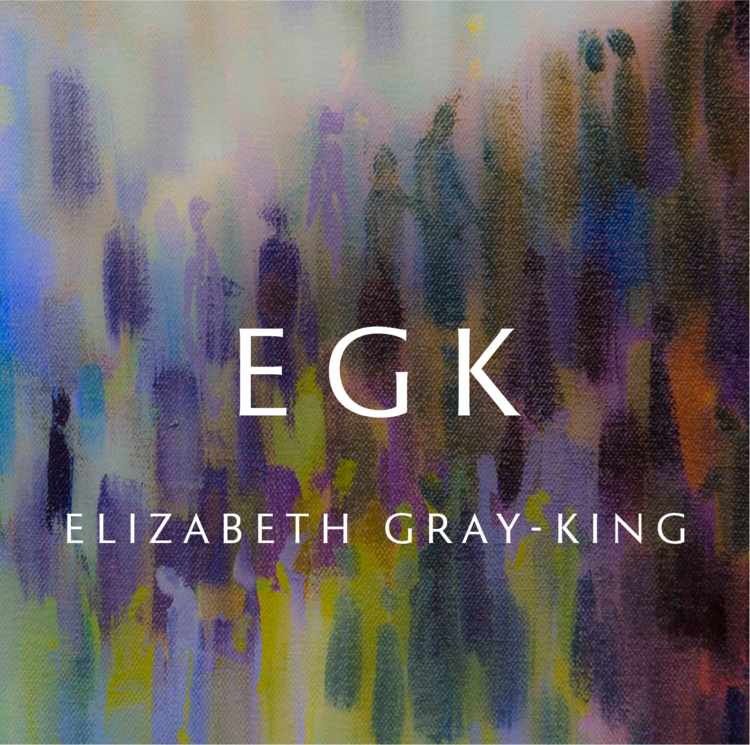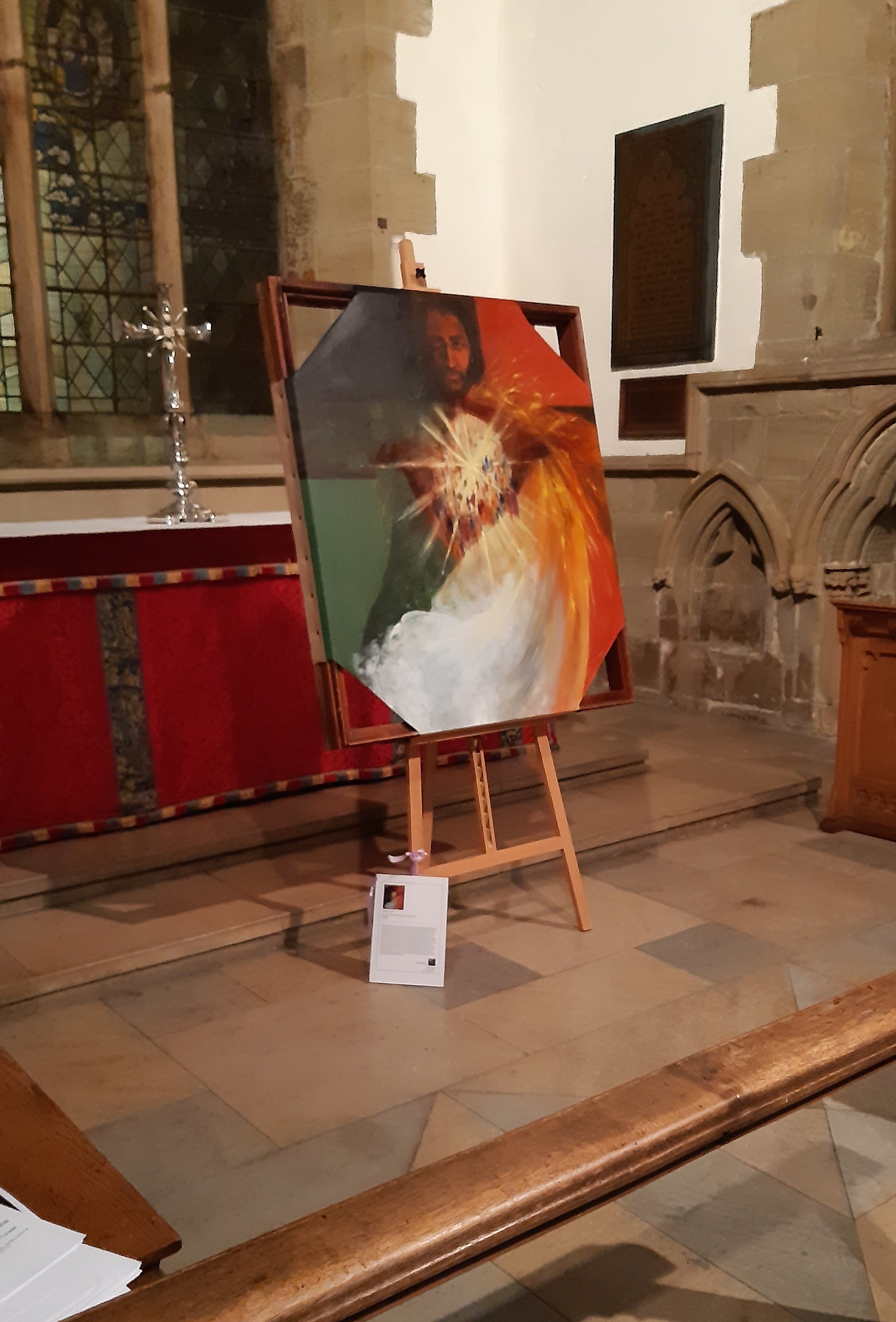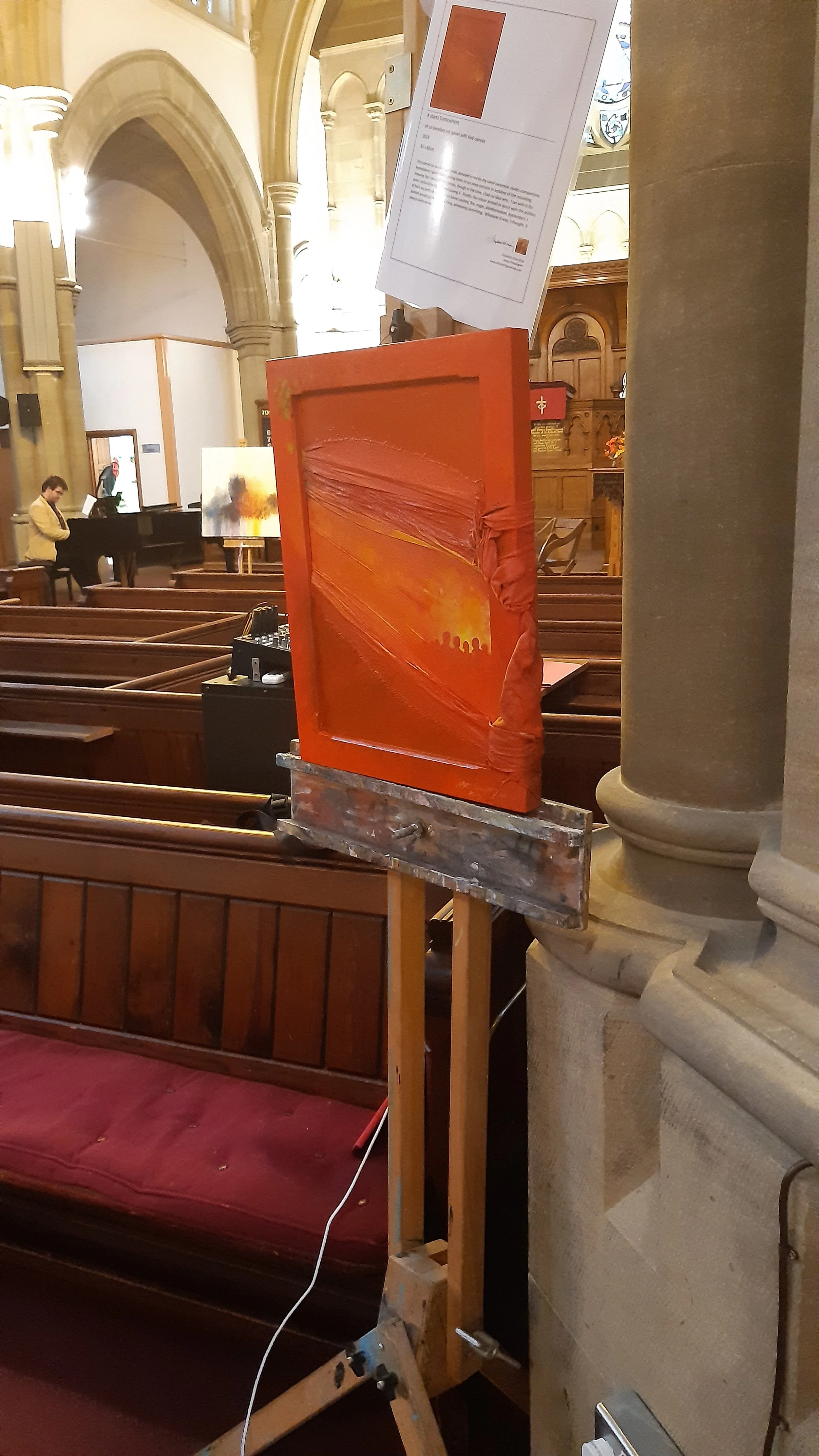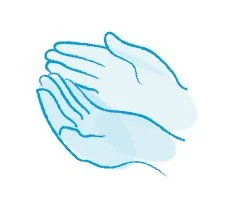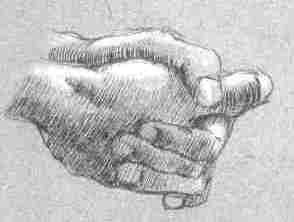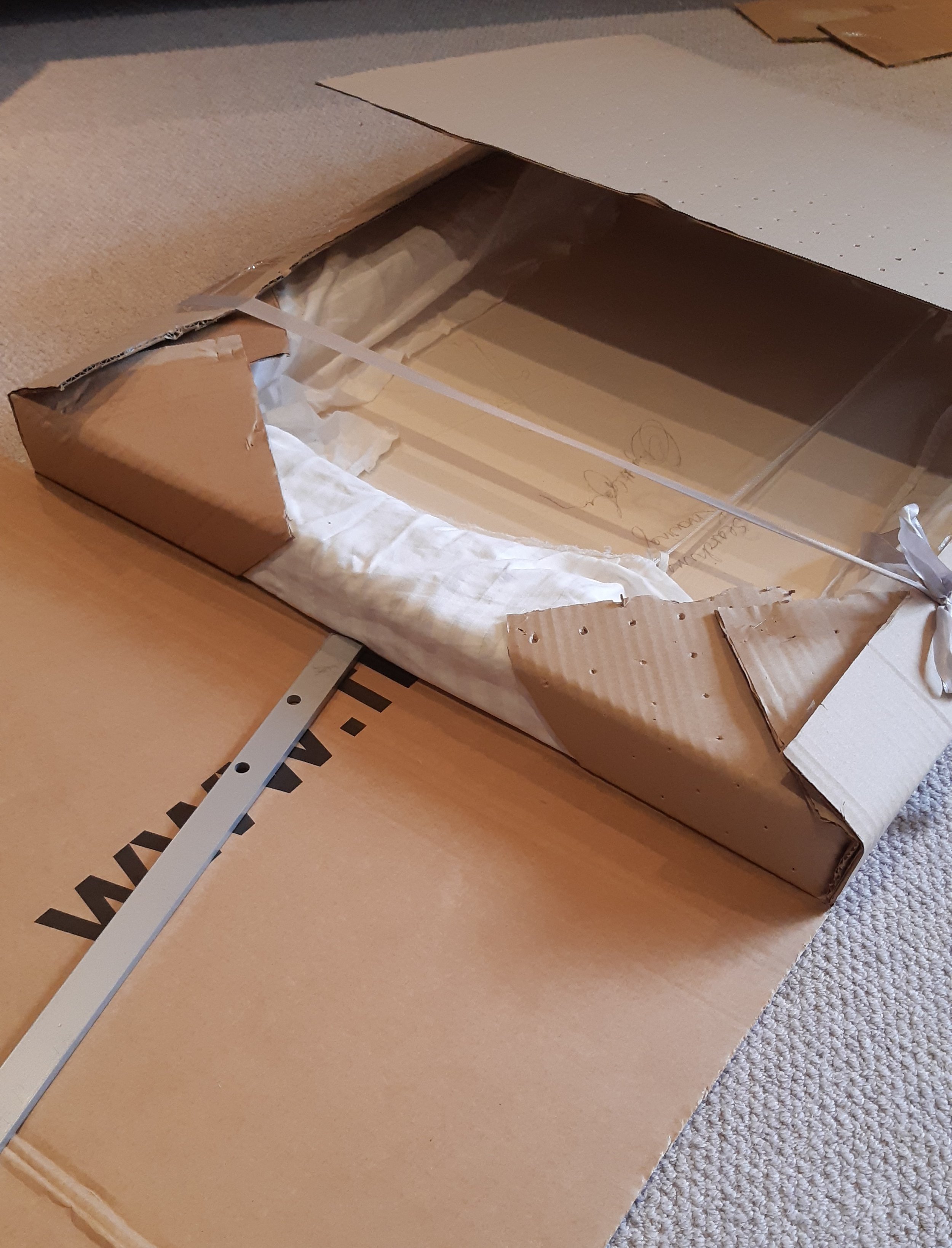Oh I’m enjoying this map! https://www.elizabethgrayking.com/exhibitions-tours-map. It shows that somehow, we’ll have managed to cover much of the UK in 2023 and 2024. Open minded and open loving artwork is making an impact and we’re delighted. Here is my Nativity Tancred next to the Nativity crib at Liverpool Parish Church.
The Exhibition continues to make a difference
My apologies! To those of you who don’t follow my newsletter, you won’t have heard details about how the exhibitions are going. As we come to Christmas time, grateful for God in Person as Jesus, I express deep gratitude for how my artwork is speaking to people of God’s love for everyone. A viewer in Newcastle saw a dance of the Trinity in Searching Knowing and another viewer said that simply being with the artwork made her feel loved and more peaceful in a stressful day.
Sunderland Minster’s pastor team danced and grinned, so excited to share Nativity Tancred for a month. Sacred Trinity Salford sang us in at the Launch with the Scholar’s choir. They stand in between Am I Free and Nativity Tancred, and in front of the rest of the artwork which hangs on the wall in a gallery style at the back of the Church. One viewer said that at last, they felt part of something bigger and they knew they were loved. In a few weeks, we collect from Salford and deliver to Liverpool Parish Church. We have already seen the perfect spot for One.
The best news is that we’ve already secured £240 for the Open Table Network, one of the purposes of the exhibition in addition to raising the profile of God’s inclusive love. We have at least six more venues for 2024 and look forward to more financial support coming to the work of the network as we look forward to sharing the work with more and more communities. If you want to see the work in person, please visit the exhibition pages. Thanks to Andre, there is even an interactive map!
Until I write again, I send you my warmest wishes for a Holiday Season which moves your soul and brings you joy and laughter.
A privilege to tour
I’m on a train to Sunderland Minster for the Open To All tour second stop. What a privilege. I’m on a train, freely moving in my resident country. I have a data signal with the network working. There are storms howling and my train is active. Then I get to set up the exbition in a church which welcomes freedom of thought, radically challenging closed stereotypes. Then I get to talk about my own work and I’m an ordained woman who will be standing in a church which still struggles with who it will recognises as leaders. I have the freedom to talk about God's inclusive love whilst parts of the world fight against this very notion. I’m privileged by my background, my colour, my knowledge. I intend to use that privilege to break down doors and shout about love and forgiveness. If I change one heart and one set of behaviours, my mustard seed will bear fruit.
Releasing Prayer with hands
One of the best things we can do for ourselves is to move what is burdening us out of our bodies. Our bodies react before our conscious brain tells us what is happening and our bodies remember and hold much which we thought we might have intellectually moved on from. If you want to know more, look up trauma work and the Vagas nerve system.
This little ritual is a way I have found to release to God the people and situations which are on my mind and heart, and therefore, which my body holds. To hold less releases me to be, as much as possible, a non-anxious presence for other people. This helps them.
Here it is:
I open my hands, palms up, the sides of my little fingers touching each other making a typical kind of offering shape.
I then speak into my hands and name the person or people weighing in my heart. I may have just been struck by a comment in an email, or a note on the news, or simply a name popping into my head. I tell the story as I look into my hands.
Then, I take my right thumb and draw the vertical line of a cross, saying, “in the name of eternal God”, then cross from left to right saying, “incarnated Christ,” then rest my thumb at the cross intersection and say, “inhabiting Spirit”*. I then change hands and with my left thumb make the cross shape and this time “may they be healed of all that harms them in body, mind and spirit” going from top to bottom on the word body, left to right with the word mind and held in the centre for the word spirit.
Next, I put my hands back together in the offering shape and fully extend and lift them, (to me) – to God. I say, “I release (the name, or ‘your children’ or the situation) to you oh God.”
I then close my hands to a typical prayer shape with my palms together and say, “in all of this, bring love, peace and justice.”
I finish by crossing my hands over my chest with the tips of my fingers to my shoulders and say, “I release (name, situation) to you Dear God and set myself aside as needed.”
I don’t do this perfectly each time. But what this does for me is get my body involved in the appeal for God’s care. This way my body remembers that I’ve done this, the worry does literally leave me, and I am ready to engage in the next thing on my list.
* Eternal God/Incarnated Christ/Inhabiting Sprit is my personal choice for naming the Trinity. For you, choose whichever name of the Trinity fits best with your own theology and personality.
What to do when we’re angry with God or with something or someone?
Stay with it. Be angry; it’s important. Then we move beyond to make it history.
I use a classic tool we can find all over the Psalms. Lament.
It’s a fine form of a prayer pattern in five sections:
1) address God (praise, acknowledge, whatever notes God is with us too)
2) make a complaint to God (moan, shout, get it all out of the system – every last awful detail of what we’re upset or angry or hurt or more about)
3) spell out our trust in God no matter the complaint (name the times we’ve got through before, name what we believe God has done for us before, no matter how angry we feel about trying to find anything at all God has done to help us before)
4) appeal to God to help or fix something, occasionally someone (what would fix this thing for us? What could anyone do? Name it all, even if it’s hard)
5) praise God, and if we can bear it, praise God with a promise of our own faithfulness to God.
This form of prayer and plead to God has long history over millennia because it helps. It works. It’s a Holy literary device because it’s a tool that releases us. It makes us set out the bare bones of our despair as we write our truth, it exposes our weakness and need, it acknowledges God’s unlimited active grace and it lets us pour ourselves into God’s profound care. If we feel the need, we can lay blame as we spell out our weakness. In Psalms we read, ‘my enemy pursues me.’ We might write, ‘they didn’t hear me yet again.’ Lament is an exposing trusting encounter with our or others’ truth, held in the extraordinary presence of God. God hears.
Like other Lament writers, I find that when I’m despairing, confused, angry, betrayed and more, I choose to force my horrendous situation into a Lament. It makes me spell it out and at the same time, whether I feel it in the moment or not, remind myself that God always knows and loves more than I can ever know. I start by blubbing out the issue, then I go to the pattern. It always makes me write that I trust God, and if I was wondering, the very writing reminds me that it’s true. In times like these, I encourage you. Trust, Lament in truth, trust even more.
I also find that doing this with an object helps. Often I find a thing, an object. Box? Card? Anything. I hold it. As I feel it and move it in my hands, I enter the Lament: praise God, name the horribleness, name how God helped me before, ask God's help in this, praise God. I put the object down and say, "with this (name the object), I place it down and put it into your hands, O God. It is no longer my burden."
Then I wait, feel and think. Countless times, the burden is lifted and I have the psychological distance to see what needs done.
The tour begins!
Here we are, packed and off to Newcastle. It looks to be a fine day for travelling and there is a lovely team waiting to help us set up much later today. Knitting for me now en route. That’s the only way I can manage motorways!
Wrapping newbies for the journey
Wrapping day. Having saved up those convenient huge boxes from the few things we needed after the studio move, they're being put to good use. I use old sheets to cover the painting face and then make corner protectors from cardboard. After that, I cut a huge box to fit and then tie the sides in with very inexpensive ribbon. It’s immensely strong and wraps and unwraps for exhibition time and time again. Good thing really, these babies will move through 10 exhibitions! Either the originals, or if sold, their prints, will travel the length of England. The Exhibitions calendar is in the left toolbar.
